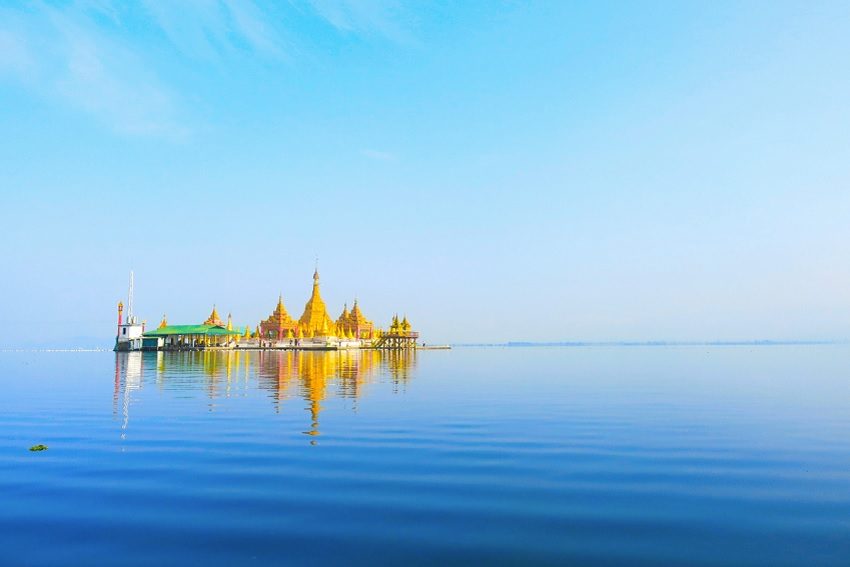Serenity Amid Conflict at Myanmar's Indawgyi Lake

Hugh Scobie takes a journey to a serenely remote lake in northern Myanmar that is largely inaccessible due to surrounding military conflicts.
Indawgyi Lake, located in the northern Kachin State of Burma/Myanmar, is a travel gem that is as rewarding as it is inaccessible. Floating golden pagodas, working elephants and a truly breathtaking number of migratory birds can all be found at the lake. While tourists have been visiting Bagan, Mandalay and Inle Lake in ever greater numbers since 2011, Indawgyi has remained largely untouched by the burgeoning tourism industry.
The main reason for this is its remoteness; Indawgyi is not connected to any major highways or railways and there are no airstrips. The closest major destination is Myitkyina, the largest city in Kachin State, from where you can catch a train south. The railways were completed at the close of the 19th century and travel at antique speeds. If you’re travelling from the south, it can take more than 24 hours. Watch out for biting insects and try to make friends with the amused locals while you roll through valleys filled by rice paddies, farmers and buffalo.

The train trundles along for roughly six hours until it reaches Hopin, a dusty crossroads town. From here, Indawgyi is across another mountaintop. Enterprising locals organise flatbed trucks going from the Hopin bus station, or braver travellers can organise a ride on the back of someone’s motorbike. The ascent is bumpy and hair-raising, but almost immediately as you cross the peaks, silvery Indawgyi Lake appears and spreads out through the valley as far as the eye can see.
Myanmar is a part of the world where poverty and wealth become very confusing — it suffers from the ‘resource curse’; abundant natural resources but a weak political system that sees the majority of the wealth flow to a small group of elites and foreign-owned companies. The northern regions have an incredible amount of gold, jade, rubies and gemstones, yet sources of cash income are rare. You’re likely to find local children dressed in rags but sporting solid gold earrings, or with a sizeable ruby decorating their nose. Due to mismanagement and some truly bizarre decisions by previous governments, including multiple instances of ‘demonetisation’, many locals distrust the national currency, the kyat. Instead, they store their wealth in gems and precious metals, which distorts how wealth is gathered, stored and traded.

The lakeside hamlet Lonton has the only ‘tourist approved’ guesthouses that foreigners are allowed to stay in. But one of these is often reserved for use by the Tatmadaw, the military forces of Myanmar, and may not be available. This is because Kachin State, similarly to other areas of Myanmar, is the site of a long-standing military confrontation between the Tatmadaw and the Kachin Independence Organisation (KIO). The KIO fight for the equal rights of the Kachin, the largest ethnic group of people in Kachin State, and have control over northern regions of the state and along the Chinese border. The conflict began in the early ‘60s because of the nationwide coup d’e tat staged by Ne Win. Today, there is ongoing conflict in the region, despite several ceasefire agreements and attempts at a peaceful political solution.
Despite this, Lonton and Indawgyi are sleepy, peaceful places. Most residents make their living from the lake through fishing, through the abundant forests, or by trying to strike it lucky mining gold, silver or the precious gemstones that fill the region.
Recently, in response to the trickles of intrepid tourists who make the journey, a group of younger residents have established a small tourism business. They will happily take you out kayaking on the lake or organise a birdwatching tour while practising their English phrases and words with you. You can also hire bicycles to cycle around the lake, or ask a fisherman to drive you to some of the secluded, picturesque spots.

Indawgyi is home to nearly 100 different species of migratory birds; cranes, herons, kingfishers and plovers all migrate to the lake at different times of year. Some travel from as far as Russia and Australia. As a result, the lake is part of the international Ramsar convention that aims to protect important migratory habitats. This attracts birdwatchers from all over the world; another migratory species just as curious and varied as the birds themselves.
The big tourism drawcard at the lake is man-made, though. Shwe Myitzu Pagoda draws thousands of domestic tourists each year and should not be missed. It is a ‘floating’ pagoda built several hundred metres from the shore of the lake during the 19th century, before British colonialism disrupted the country. The pagoda itself is nearly 16 metres high and covered with gold leaf, gold paint and precious stones. Tourists are welcome to visit, and the sunrises and sunsets are truly breathtaking as sunlight peeks over the mountains, sparkling onto the towers and the water.
While it is difficult to get to, Indawgyi Lake offers a peacefulness that is rarely found in the more heavily visited areas of Myanmar. Locals are more interested in your strange clothes and bizarre habits than trying to separate you from your money, and the pace of life is slow and laidback. A truly rewarding destination for those who make the journey.
Please note: Smart Traveller currently advises a high degree of caution regarding travel to Myanmar. For more information, go to smartraveller.gov.au